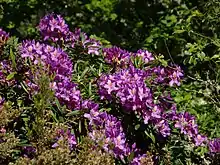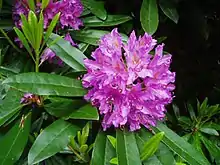Rhododendron ponticum
Rhododendron ponticum, called common rhododendron or pontic rhododendron, is a species of Rhododendron native to the Iberian Peninsula in southwest Europe and the Caucasus region in northern West Asia.
| Rhododendron ponticum | |
|---|---|
 | |
| Scientific classification | |
| Kingdom: | |
| (unranked): | |
| (unranked): | |
| (unranked): | |
| Order: | |
| Family: | |
| Genus: | |
| Subgenus: | |
| Species: | R. ponticum |
| Binomial name | |
| Rhododendron ponticum | |
| Synonyms[1] | |
|
List
| |

Description
R. ponticum is a dense, suckering shrub or small tree growing to 5 m (16 ft) tall, rarely 8 m (26 ft). The leaves are evergreen, 6 to 18 cm (2.4 to 7.1 in) long and 2 to 5 cm (0.79 to 1.97 in) wide. The flowers are 3.5 to 5 cm (1.4 to 2.0 in) in diameter, violet-purple, often with small greenish-yellow spots or streaks. The fruit is a dry capsule 1.5 to 2.5 cm (0.59 to 0.98 in) long, containing numerous small seeds.
It has two subspecies:
- R. p. baeticum (Boiss. & Reut.) Hand.-Mazz. – Found in central and southern Portugal and southern Spain (in the Province of Cádiz).[2]
- R. p. ponticum – Found around the southern Black Sea Basin (eastern Bulgaria, northern Turkey, Georgia, Northern Caucasus) and central Lebanon.[3]
And a variegated variety:
Distribution and habitat
The species has two disjunct populations one in the southwestern Iberian Peninsula (central and southern Portugal and southwestern Spain) and the other near the southern Black Sea Basin (eastern Bulgaria, northern Turkey, Georgia, and Northern Caucasus). It has also been introduced to Madeira, India, Belgium, England, France and Ireland.[3]
The range in the Iberian Peninsula is limited to mountain ranges, the Caramulo mountains, the Monchique range and the Aljibe range. A remnant of the original laurissilva forests that covered the peninsula 66 million yeras ago.[5]
Though it was in Great Britain before the last Ice Age, it did not recolonise afterwards and the modern ecology of the island developed without it. Its presence today in Great Britain is due to humans introducing it, and it easily naturalises and becomes a pest in some situations, often covering whole hillsides (especially in Snowdonia and the western British Isles). In the British Isles, it colonises moorlands, uplands, shady woodlands (alongside escaped laurels and the native holly) and in areas of acid soils, often in shaded areas.
Historical range
Fossil evidence shows it had a much wider range across most of southern and western Europe before the Late Glacial Maximum, or until about 20,000 years ago.
It was noted by the botanist Joseph Pitton de Tournefort during his travels in the Near East in 1700–02, and so received its name from Linnaeus to identify the ancient kingdom on the south shores of the Black Sea, Pontus, in which it grew. At the other end of its range, in southern Spain, Linnaeus' friend and correspondent Clas Alströmer found it growing with oleander. It was introduced to Britain as an ornamental shrub in 1763, and later planted as cover for game birds. It is now considered to be an invasive species.[6]
Cultivation and uses

Rhododendron ponticum subsp. baeticum is one of the most extensively cultivated rhododendrons in western Europe. It is used as an ornamental plant in its own right, and more frequently as a rootstock onto which other more attractive rhododendrons are grafted. The plants were first grown in Britain in the 1760s, supplied by Conrad Loddiges, and became widely distributed through the commercial nursery trade in the late 18th and early 19th centuries. The roots readily send up suckers from below the graft, often allowing it to overtake the intended grafted rhododendron.
Honey produced with pollen from the flowers of this plant can be quite poisonous, causing severe hypotension and bradycardia in humans if consumed in sufficient quantities, due to toxic diterpenes (grayanotoxins).[7]
In some parts of the world, a controlled dosage of the honey can be taken to induce hallucinations for spiritual or psychological purposes. Such areas include Nepal.[8]
Invasive species
Suckering of the root, together with its abundant seed production, has led to it becoming an invasive species over much of western Europe and in parts of New Zealand. Rhododendron control is a key element in nature conservation in those areas.[9] Conservation organisations in Britain now believe R. ponticum has become "a severe problem" in the native Atlantic oakwoods of the west highlands of Scotland and in Wales, and on heathlands in southern England, crowding out the native flora.[10] Clearance strategies have been developed, including the flailing and cutting down of plants with follow-up herbicide spraying. Injection of herbicide into individual plants has been found to be more precise and effective.[11]
A study[12] in the journal Functional Ecology also showed that invasive rhododendron nectar was toxic to European honeybees (Apis mellifera), killing individuals within hours of consumption. It also paralyzed bees of the species Andrena carantonica, a solitary mining bee. Bees became paralysed and exhibited excessive grooming or other distress behaviours after feeding on Rhododendron nectar, and ate less food than bees fed a control nectar. In contrast the buff-tailed bumblebee (Bombus terrestris) was not affected by the rhododendron nectar.
See also
- Catawbiense hybrid – hybrid with R.ponticum
References
- "Rhododendron ponticum L." Plants of the World Online. Board of Trustees of the Royal Botanic Gardens, Kew. 2017. Retrieved 27 September 2020.
- "Infraspecific Taxon Details : Rhododendron ponticum subsp. baeticum (Boiss. & Reuter) Hand.-Mazz". Catalogue of Life. Retrieved 21 November 2020.
- "Infraspecific Taxon Details : Rhododendron ponticum subsp. ponticum". Catalogue of Life. Retrieved 21 November 2020.
- "Infraspecific Taxon Details : Rhododendron ponticum var. heterophyllum R. Ansin". Catalogue of Life. Retrieved 21 November 2020.
- "A adelfeira de Monchique". University of Évora. Retrieved 21 November 2020.
- Alice M. Coats, Garden Shrubs and Their Histories (1964) 1992, s.v. "Rhododendron"; http://www.countrysideinfo.co.uk/rhododen.htm#Introduction%20to%20Britain .
- Hayes, Andrew Wallace (2007). Principles and methods of toxicology. CRC Press. p. 998. ISBN 978-0-8493-3778-9.
- https://themadhoney.com/
- "New flora and fauna for old". The Economist. 2000-12-21. Archived from the original on 2001-07-28. Retrieved 2008-12-14.
- "Rhododendron: A killer of the Countryside". Offwell Woodland & Wildlife Trust. 2004. Retrieved 30 May 2010.
- "BREAKTHROUGH IN BATTLE AGAINST PROBLEM PONTICUM". Forestry Commission. 30 July 2004. Archived from the original on 5 March 2011. Retrieved 30 May 2010.
- Tiedeken, Erin Jo; Egan, Paul A.; Stevenson, Philip C.; Wright, Geraldine A.; Brown, Mark J. F.; Power, Eileen F.; Farrell, Iain; Matthews, Sharon M.; Stout, Jane C.; Manson, Jessamyn (November 2015). "Nectar chemistry modulates the impact of an invasive plant on native pollinators" (PDF). Functional Ecology. 30 (6): 885–893. doi:10.1111/1365-2435.12588.
External links
| Wikimedia Commons has media related to Rhododendron ponticum. |
- Flora Europaea: Rhododendron ponticum
- Rhododendron Ponticum is the emblem and symbol of Bulgaria's most exotic National Park – The Strandja mountains
- "Rhododendron ponticum". Germplasm Resources Information Network (GRIN). Agricultural Research Service (ARS), United States Department of Agriculture (USDA).
- Centre for Conservation Strategy: Rhododendron ponticum in Britain
- Danish Rhododendron Society: Rhododendron ponticum in Europe
- Milne, R. I., & Abbott, R. J. (2000). Origin and evolution of invasive naturalized material of Rhododendron ponticum L. in the British Isles. Molecular Ecology 9: 541–556 Abstract.